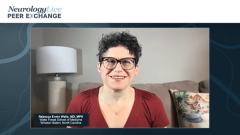
Goals of Preventative Therapy for Migraine
Expert neurologists share their goals and patient considerations for preventive migraine therapy.
Episodes in this series

Jessica Ailani, MD: When we’re talking about prevention, when do we start considering preventive treatment? Rebecca, I wonder if you have some words to share with us about prevention? What are the goals of preventive therapy? When do we start considering prevention in our patients?
Rebecca Erwin Wells, MD, MPH: This is such a great question. When we’re thinking about preventive therapy, we’re targeting the headache in terms of the frequency, the severity, the duration, and disability. On top of that, 1 goal is to decrease the likelihood of a headache happening. But when headaches do occur, we want to ensure that patients are able to be responsive to their acute treatments. Many times, when our patients get on a good preventive option, it not only decreases the frequency and the severity of their attacks but then makes their acute treatment options even more powerful, so they become more responsive to acute treatments.
In addition, we want to improve overall function and reduce disability, so patients are able to live their lives despite having migraine. One other thing that’s important is improving the overall quality of life and decreasing the psychological distress and health-related distress associated with migraines. We often start thinking about preventive treatment when patients are having headache attacks that are frequent enough that we start thinking about preventive along with disability.
There’s a range when we start thinking about whether to offer or consider preventive treatment options. When we think about offering it, we think about 6 or more headache days a month with no disability, 4 or more headache days a month with some disability, and 3 or more headache days a month with severe disability. This is the recommendation from the most recent American Headache Society Consensus Statement. But the way I remember it is basically 1 a week. If patients are having about 1 headache a week, that’s the point at which many preventive treatment options should be considered. I’m often surprised at how many patients are having attacks 2 or 3 times a week. They’re taking over-the-counter medications and will begin saying, “I’m not sure about taking a preventive.” I acknowledge that, but you’re taking over-the-counter medications that have adverse effects and risks with the frequent use that you’re using. It’s a transition to a preventive option at that point.
Jessica Ailani, MD: It’s funny when you talk to patients about their over-the-counter medication use. What happens is patients are used to what they know, so we’re introducing the idea of what is unknown vs what is known; it’s that fear.
You make a very good point about disability. What is very well known to the patient is their disability in the burden of their disease. If we turn the conversation to their disability and the burden of their disease, sometimes that strikes a note, and it makes it easier to talk to them about prevention. Stephanie, do you have any tips on how you can have that conversation about the impact of the burden of disease with a patient and the impact of the quality of life? You’re seeing many refractory patients at the Jefferson Headache Center, which is a tertiary care center for headache specialists sending patients over, so sometimes you’re seeing the most burdened. How do you have that conversation and get patients to understand that burden?
Stephanie J. Nahas, MD, MSEd, FAHS, FAAN: First, you have to have it in the forefront of your mind that this is an important question. We focus so much on headache days per month and migraine days per month. That’s what the clinical trial primary end points are all about— reduction in mean monthly migraine days. We look at other things like reduction in acute medication use, function, quality of life, etc. But that stuff is what’s most important in helping you understand how migraine is affecting that individual. Our patients have no trouble verbalizing this and expressing it. It’s almost a given when they come to us, most of the time, but not exclusively.
But many clinicians out there may have to drag this out of their patients because they don’t necessarily want to admit how much migraine is affecting them. When you have these conversations, you’d better be prepared for some emotionality. This is 1 of the reasons we always keep tissue boxes in every office, because it could be quite a gut-wrenching discussion.
If you want 1 simple question to ask your patient to start this conversation, it’s a brave 1, but I suggest you put it into your armamentarium. Simply ask them, “What would your life be like without migraine?” If they give you a quick short and sweet answer, maybe they don’t need prevention. They just need some coaching and a good acute treatment. But most of your patients will start to go on a litany of reasons and changes in their life that they could see, a litany of concerns that they have because of their unpredictability of attacks that could take them out of the worse possible moment.
These are the things that go through patients’ minds between attacks. It speaks to the importance of assessing patients in their interictal period. Don’t focus just on headache attacks and headache days. What’s happening on the other days? Are they limiting themselves because they’re afraid they’re going to bring on an attack? Have they changed their life trajectory because they have this disease that has made them unpredictably incapacitated? We have plenty of patients who said, “I had to choose a different career,” or “I didn’t have as many children.” It’s far reaching, and it can be pervasive how a migraine can affect somebody and weave its way into every aspect of their lives.
Jessica Ailani, MD: You reminded me of a publication. Chris, I wanted to bring this to you because you’re nodding along. Just to briefly mention, a publication I read not long ago reminds me of many of my patients. This publication was mentioning the number of women who decide not to have children because of migraine. Many of our patients have made the decision to be a surrogate parent or decide not to have children because the burden of disease is so great.
Thank you to our audience for watching this Neurology Live® Peer Exchange. I hope that you’ve enjoyed watching this program as much as we’ve enjoyed spending this time together. If you have enjoyed this content, please subscribe to our e-newsletters to receive upcoming Peer Exchanges and other great content right in your in-box.
Transcript edited for clarity.
Newsletter
Keep your finger on the pulse of neurology—subscribe to NeurologyLive for expert interviews, new data, and breakthrough treatment updates.




































